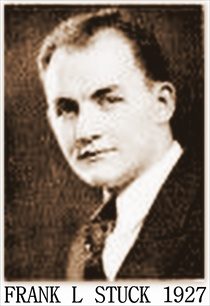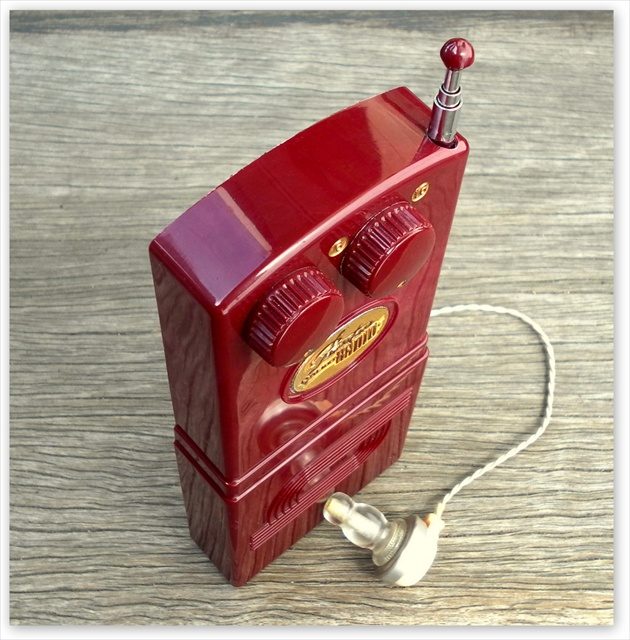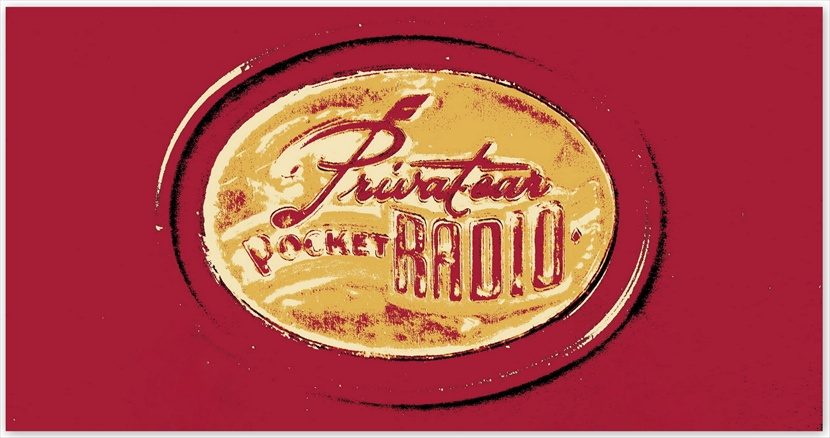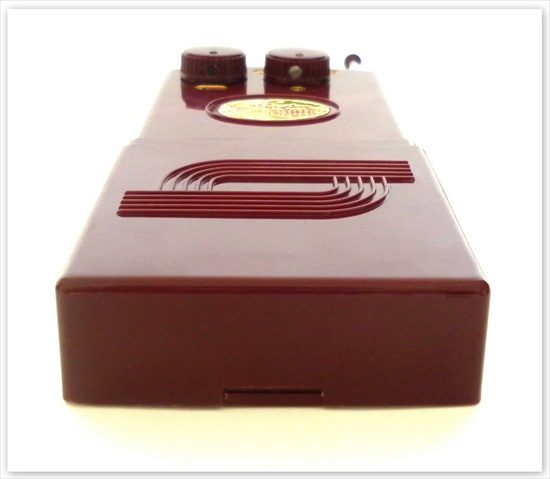
Forward: Researching this radio was a satisfying and rewarding experience. I discovered who invented it via the patent and from there delved deeper into the past by way of old newspaper and magazine articles, the 1930 and 1940 U.S Census and telephone directories etc. As far as I can tell this is the first time the story of the Privat-ear has been told. It is fully referenced at the bottom of the page.
The Privat-ear pocket radio was manufactured in the USA and released onto the market by Electronics Systems Corporation in 1949 (1a,b, c). Although small enough to fit in a shirt pocket this is not a transistor radio; it owes its small size to the use of subminiature tubes developed during WWII and was designed as an earphone only model. It predates the first commercially available transistor radio by five years and was an innovative, but ultimately doomed, attempt at realizing an American cultural objective; the creation of a portable shirt pocket radio with mass appeal.
The Privat-ear was invented by Frank L Stuck, a Minister of Lakeland Florida. Born in  Washington, Pennsylvania on October 13 1904 to William and Maise Stuck, he was the second youngest of four children (1d, e). He studied Theology at Bethany College, West Virginia from 1924 — 1927 and received a Doctor of Divinity degree from the American Theological Seminary at Wilmington Delaware (1f). Whilst attending College he was one of the founding members of Alpha Pi Alpha, was a member of the Student Volunteers and met and married Iva Myrtle Driggs.
Washington, Pennsylvania on October 13 1904 to William and Maise Stuck, he was the second youngest of four children (1d, e). He studied Theology at Bethany College, West Virginia from 1924 — 1927 and received a Doctor of Divinity degree from the American Theological Seminary at Wilmington Delaware (1f). Whilst attending College he was one of the founding members of Alpha Pi Alpha, was a member of the Student Volunteers and met and married Iva Myrtle Driggs.
Frank L Stuck might have developed a keen interest in electronics whilst attending college and was most probably a part-time radio enthusiast and hobbyist. He may have been inspired from an early age by the popular writings of Science Fiction Author, futurist and ‘promoter of all things radio’ Hugo Gernsback.
Gernsback founded numerous technical and radio themed magazines including the USA’s first radio magazine ‘Modern Electrics’ in 1908. His popular magazines were aimed at electronics hobbyists and through them he promoted, amongst other things, the idea of ‘pocket wireless apparatus’. Gernsback’s prescribed ideology progressed through the early 1920’s alongside the development of miniature crystal sets and the first fully contained (speaker, loop antenna, batteries, tubes) portables. At this time only crystal sets could be built pocket sized and the limited selection of portable radios available were housed in large, heavy briefcases. Neither option was particularly appealing to the average American consumer.
In 1929 the stock market crashed bringing on the Great Depression. This resulted in thousands of banks closing and millions of Americans losing their jobs. Times were tough but over the next decade Reverend Stuck managed to find Ministry positions in three West Virginia towns bringing hope and solace to local parishioners. Radio too became a source of comfort and warmth (literally!) to struggling families who gathered in the evening to listen to popular broadcasts. The ‘fireside chats’ of newly elected President Roosevelt were particularly reassuring and the emergence of new shows, radio stars, sports broadcasts and the like only served to increase its audience. The popularity of radio exploded and by 1937 it is estimated that almost 23 million American families owned a radio. Radio had become more than an electronic box filled with tubes and wires, it had taken on a more intimate quality and was now indispensable to a families emotional and social well being.
In 1939 Americas love affair with the airwaves continued to bloom and the genesis of the shirt pocket radio came one step closer with the development of miniature tubes by RCA and smaller ‘B’ batteries by Eveready. This enabled further reduction in the size of portable radios; one example being the popular RCA Victor BP10, marketed in 1940 and measuring just 8.85″ x 3″ x 3.6″.
In 1941 America entered WWII and its consumer electronics industry was quickly directed towards churning out supplies and equipment for the military. This concentrated effort led to innovations such as the printed circuit board and the development of tiny subminiature tubes by Raytheon, making further miniturisation of radios possible. At the close of the war defense contractor Raytheon looked at various projects for maintaining the company’s profitability during peacetime. One of the proposals put forward was to build a shirt pocket radio. Raytheon implemented this idea by purchasing the Belmont Radio Corporation and then assigning one of their own engineers the responsibility of designing the set. The earphone only Belmont Boulevard made its debut in December 1945. It measured 6.25″ x 3″ x 0.75″ and incorporated their newly designed subminiature tubes (1g) It was the first commercially available shirt pocket radio; however it lacked mass appeal and did not meet expectations. Sadly total sales reached only 5000 at most (1h).
The Belmont Boulevard was a cutting-edge, visionary device. A year earlier Gernsback had stated that «Pocket and vest pocket radios fill a real demand» and he predicted that «before long many millions of these radios will be built annually». He was right, but his predictions were too soon for the Belmont Boulevard. Its suave look and design appeal to us now but it seems that in 1945 it was simply to far ahead of its time for the American consumer to appreciate it. A range of factors contributed to its failure but probable reasons include its high purchase price ($65.00) and the need for frequent battery changes, its average audio performance and its similarity in appearance to hearing aids of that era. This particularly negative association with the ‘hard of hearing’ was reinforced by having to use an earphone. It was just not fashionable.
Meanwhile Reverend Stuck moved his family to Lakeland Florida. Clearly he still believed that a radio similar to the Belmont Boulevard was a viable enterprise as he went ahead and filed his patent on May 8th 1947 (1c, i). See the original patent here. Production of the Privat-ear began some time after and it appeared in the October 1949 edition of Mechanix Illustrated. It employed a two tube reflex circuit and measured just 5.75″ x 2.25″ x 0.9″. Sadly Frank L Stuck passed away two months earlier whilst addressing a Civitan meeting in Bristol Virginia. Speech notes that the Reverend had penned at the time included the cryptic phrases «stand to death» — «rain no game» — «where do you get a lawyer?» and «Adm Byrd», a reference to famed explorer and American Naval Officer, Admiral Richard E Byrd (1e). Admiral Byrd was from a notable Virginia family and perhaps Reverend Stuck used him as a source of inspiration, or maybe he just wanted to sell him some radios!
By December 1950 Electronics Systems Corporation had either changed its name or the company had been sold and now traded as Privat-ear Corporation. The address of the company had also changed from 112 West 18th Street Kansas City to 2016 Bronxdale Avenue New York. See both addresses here.
The Privat-ear was sold from late 1949 until at least April 24 1954 and ranged in price from $19.95 to $28.95. Privat-ear radios were sold in drugstores and radio shops, they were sold in specialist hearing aid shops, department stores, to the Navy and even at Abercrombie & Fitch! Interestingly in 1954 Privat-ear Corp ran an ad in the New Yorker Magazine indicating that its radio could be purchased either at famous Chicago retailer Von Lengerke & Antoine or alternatively a cheque or money order could be sent to ‘Privat-ear Corporation Blacksburg Virginia a Division of the Instrument Corporation of America’. Sounds very grand and it was also the last known change of address for the company (10)
Several other earphone only pocket radios using subminiature tubes appeared on the market during this time. They included the ‘Pocket-Mite’ kit set radio advertised for $6.99 in the July 1948 edition of Popular Science (1j). The 3 tube ‘Micro Pocket Radio’ was featured alongside the Privat-ear in the October 1949 edition of ‘Popular Mechanics’ (1k). Also interesting is the two-tube ‘Tiny Tooner’ radio from Chicago, circa 1950. The Privat-ear was the only one of these radios to be encumbered by a large telescoping antenna.
In 1951 Hugo Gernsback’s magazine ‘Radio Electronics’ assessed the Privat-ear and it was said to «provide sensitive reception with adequate volume» -even «pulling in stations from as much as 50 miles away».
Author Michael Brian Schiffer called the Privat-ear «the most stylish and popular set of this genre» -and «a modest success».
The Privat-ear was a good performer, it received a favourable review in Gernsback’s magazine and was sold for five years yet it could not breach the gap between mildly successful niche market curio and lucrative mass market appeal. Arguments against it include the use of an awkward, protruding antenna, and an earplug that implied the same negative connotations encountered by the Belmont Boulevard; an image of unhealthy infirmity was not one that the makers wanted to convey. But the final nail in the coffin was just around the corner…
The birth of the transistor radio in 1954 ushered in a new era in micro electronics, a cultural objective had been realised and the grim reaper of the electronics underworld swept up the little Privat-ear; another heroic pretender that didn’t quite make it… It does however have its place in history as one of the worlds first commercially available shirt pocket radios.



